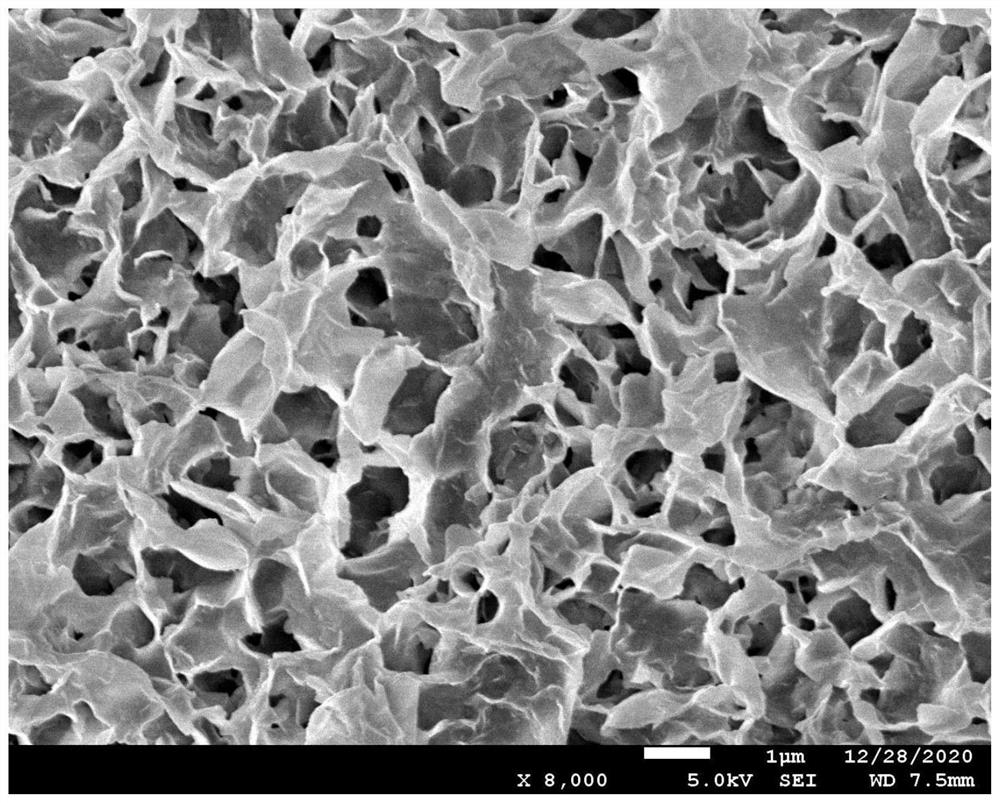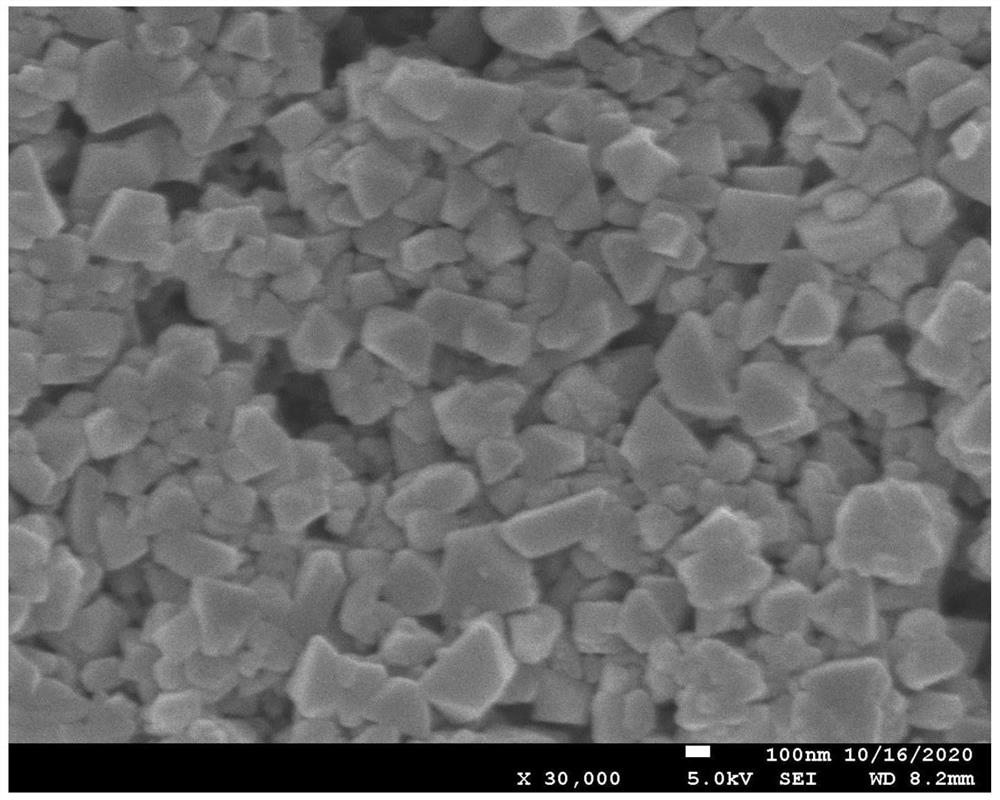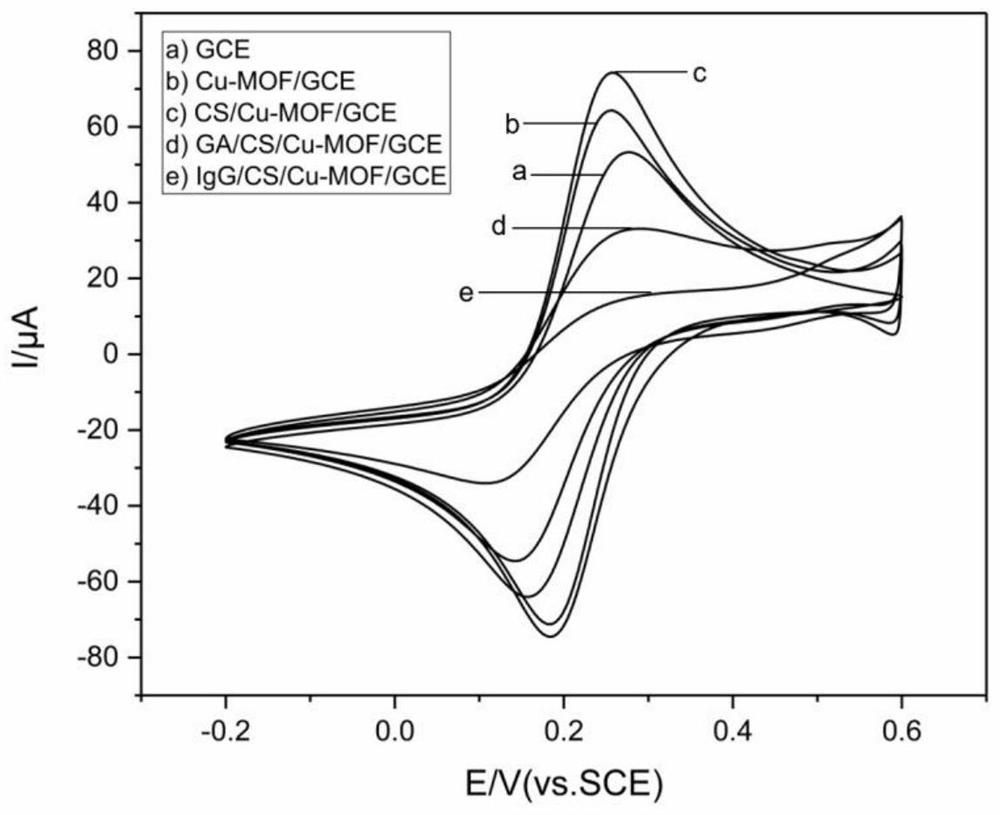Molecularly imprinted electrochemical sensor of electric copper-based MOFs sensitive membrane modified electrode and preparation method and detection method thereof
A technology of molecular imprinting and modifying electrodes, applied in the field of electrochemical sensing, can solve the problems of unclear morphology, unclear crystal form, and no clear elaboration of influence, etc., and achieve the effects of good conductivity, time saving and high sensitivity.
- Summary
- Abstract
- Description
- Claims
- Application Information
AI Technical Summary
Problems solved by technology
Method used
Image
Examples
Embodiment 1
[0039] 1. A molecularly imprinted electrochemical sensor of an electric copper-based MOFs sensitive film modified electrode, comprising a working electrode, characterized in that, outside the working electrode, a Cu-MOF sensitive film, a chitosan film, and a crosslinking agent are sequentially connected The target protein insulating layer and the polypyrrole molecularly imprinted layer, the polypyrrole molecularly imprinted layer has target protein imprinted holes.
[0040] 2. The molecularly imprinted electrochemical sensor according to claim 1, wherein the working electrode is a glassy carbon electrode, and the electric copper-based MOF sensitive film is a modified electrode, which is a novel highly ordered porous material , has the advantages of large specific surface area, porosity and adjustable function. The surface film is formed by stacking 100nm MOFs, and the surface is relatively dense. The MOFs are directly electrodeposited on the conductive substrate through the e...
Embodiment 2
[0047] 1) Weigh 10mmol copper nitrate trihydrate (Cu(NO 3 ) 2 ·3H 2 O), 15mmol 1,3,5-trimellitic acid (H 3 BTC) and 10mmol triethylamine hydrochloride (Et 3 NHCl) was dissolved in 50 mL of N,N-dimethylformamide (DMF);
[0048] 2) Deposit Cu-MOF on the surface of glassy carbon electrode by electrodeposition method. The electrodeposition process adopts the constant potential mode, and the electrodeposition is -1.3V for 5 minutes. After the end, the electrode is quickly taken out of the deposition solution and dried for later use. The prepared electrode was named Cu-MOF / GCE.
[0049] In the present invention, the specific steps of preparing the molecularly imprinted electrochemical sensor of human immunoglobulin G are as follows:
[0050] 3) Weigh 3 μL of 0.25mg / mL (in 0.02mol / L acetic acid) chitosan solution and drop it on the surface of the electrode, dry it at room temperature and name it CS / Cu-MOF / GCE.
[0051] 4) Add 10 μL of 2.5% glutaraldehyde solution dropwise on ...
Embodiment 3
[0057] Detection based on the molecularly imprinted electrochemical sensor prepared in Example 2:
[0058] 1) Immerse the modified electrode to 50mmol / l[K 3 Fe(CN) 6 ] in 1mol / l KCl solution, and then perform electrochemical voltammetry scanning and AC impedance measurement on each modified electrode, and the corresponding cyclic voltammetry (CV) diagram and AC impedance (EIS) diagram can be obtained after scanning.
[0059] 2) The prepared electrochemical sensor was immersed in the human immunoglobulin G standard solution containing 0, 0.001, 0.01, 0.05, 0.1, 0.5, 1, 5 ng / mL, and measured by differential pulse voltammetry (DPV). The degree is plotted against the DPV response value.
[0060] 3) Lysozyme (Lysozyme), human serum albumin (Human Serum Albumin) and bovine serum albumin (bovine Serum Albumin) were selected as structural analogues of human immunoglobulin to determine the selectivity of MIP / CS / Cu-MOF / GCE.
[0061] as attached Figure 4 As shown, there is a good li...
PUM
 Login to View More
Login to View More Abstract
Description
Claims
Application Information
 Login to View More
Login to View More - R&D
- Intellectual Property
- Life Sciences
- Materials
- Tech Scout
- Unparalleled Data Quality
- Higher Quality Content
- 60% Fewer Hallucinations
Browse by: Latest US Patents, China's latest patents, Technical Efficacy Thesaurus, Application Domain, Technology Topic, Popular Technical Reports.
© 2025 PatSnap. All rights reserved.Legal|Privacy policy|Modern Slavery Act Transparency Statement|Sitemap|About US| Contact US: help@patsnap.com



